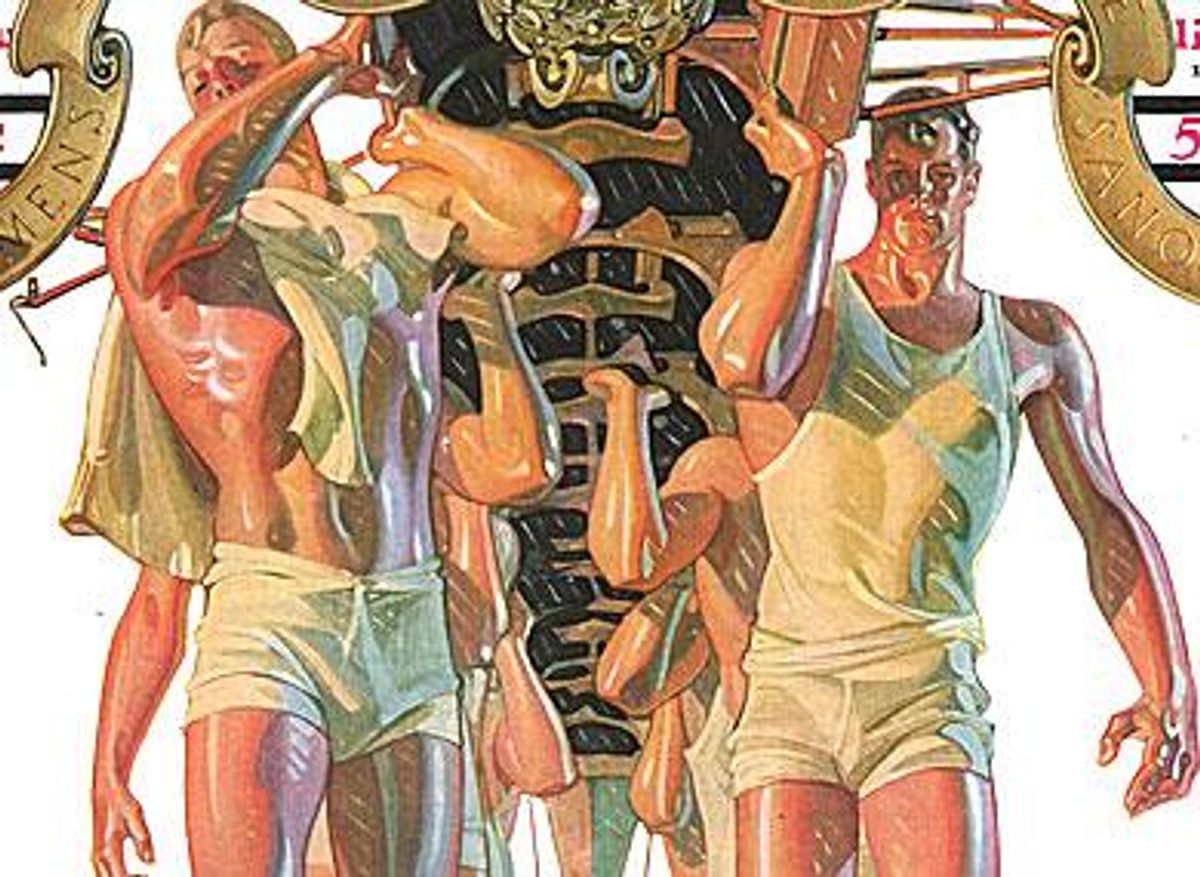
Tom of Finland's first submissions to the underground gay magazine Physique Pictorial came in 1956. By the second half of the 20th century, censorship laws had relaxed and allowed artists like Tom greater freedom in depicting the nude male in art. But the first half of the century demanded that artists play it more subtly and coded. Often they destroyed their work of a more gay or erotic nature, or kept it under lock and key.
Here we look at the paintings from six of these artists through 21st-century eyes, and it's hard to fathom not seeing the gay subtext in their work. One seems to even flaunt the male erotic figure in the most mainstream of all venues -- The Saturday Evening Post.
And yet all these six artists were respected and collected, commercially viable producers for the pre-Kinsey crowd.
Thomas Eakins
July 25, 1844 - June 25, 1916
Eakins was a realist of the early 20th century. His soulful portraits and evocative location pieces were devoted to education and scientific exploration. He was also a developed figurative artist with a deep interest in the structure and machinery of the human body. Eakins was a sexual free spirit, and his relationships with his students and his models -- both male and female -- created scandals that almost eclipsed his reputation as an artist.
J.C. Leyendecker
March 23, 1874 - July 25, 1951
This prolific American illustrator was the creator of the Arrow Collar Man, and like the later illustrator Norman Rockwell, Leyendecker is almost exclusively associated with one publication: The Saturday Evening Post. Leyendecker produced over 400 magazine covers, 322 for the Post alone. Between the Post, his work for U.S. military campaign posters and promotions, and his art for men's fashion companies -- most notably the Arrow Shirt Collar Co. -- Leyendecker created a gold mine of male beauty. His lucrative commissions financed a hedonistic Roaring Twenties lifestyle with his lover and favorite model, Charles Beach.
Marsden Hartley
January 4, 1877 - September 2, 1943
After a hardscrabble childhood, Hartley was fortunate enough to study for a year with William Merritt Chase at his school. On an art retreat, he developed a strong pull toward Eastern religion and thought. His friendship with Alfred Steiglitz was a turning point and the occasion for his first show, in 1912. In 1914 after spending time with Gertrude Stein in Paris he landed in Weimar-era Berlin, a city of open sexual expression for gay men and women. His affair with a Prussian military officer influenced much of his work for years to come.
Charles Demuth
November 8, 1883 - October 23, 1935
Demuth's most famous painting, I Saw the Figure 5 in Gold, came later in his life (1928) and aimed the arrow of modernism toward the eventual target of pop art. But before that, his early career vacillated between lush watercolors of fluid line and sensuous fleshy details to precisionist images of silos and industrial machinery. Not flamboyant, he was still drawn to the bohemian life in Greenwich Village of the time and produced a cache of erotic works that were meant to entertain his friends but were unexhibitable during the period. He met Marsden Hartley in the avant-garde salons of Paris, and Hartley introduced him to Steiglitz. The Lafayette Baths in Manhattan were Demuth's favorite haunt. His 1918 homoerotic self-portrait in a Turkish bathhouse was likely set there.
Grant Wood
February 13, 1891 - February 12, 1942
Wood is the creator of one of the most widely reproduced and parodied, and generally misinterpreted, artworks in America. American Gothic was intended as an ironic view of small-town, small-minded American life. His story of lifelong repression of his homosexuality borders on tragic, but his orientation always ended up revealing itself, sometimes to his chagrin. Romantic portraits of his cherished studio assistants, with symbolist touches, and bulky muscular renderings of local ranch hands and farm boys told the real truth of this revered American icon.
Paul Cadmus
December 17, 1904 - December 12, 1999
Of all on this list, Cadmus was the pioneer who crossed over to modern gay life in both his work and his personal story. His most famous painting was the bawdy and ironic The Fleet's In. That one painting caused so much furor that it cemented his place in art history. His work -- scarce, as he often produced only one or two paintings a year in his arduous egg tempera process -- was highly sought after. In his work we see the most direct influences on Tom of Finland in Tom's renderings of urban parks peopled with muscular sailors, soldiers, and blue-collar workers. Friends with Lincoln Kirstein, George Platt Lynes, and Alfred Kinsey, Cadmus was at the center of a new society of talented modern gay men and women living more openly than ever before.
A short history of Cadmus's most famous painting from The Naval Historical Center.
1934: "The Fleet's In!" is painted by Paul Cadmus, an artist working for the Public Works of Art Project. The PWAP is combined into the WPA. The painting is selected by the WPA for inclusion in a show of PWAP art at the Corcoran Gallery of Art. The exhibition opens with the painting included. Following the publication of an adverse letter to the editor in The Evening Star (Washington, D.C.) and subsequent outcry, Secretary of the Navy Claude A. Swanson orders Assistant Secretary of the Navy Henry Latrobe Roosevelt to remove the painting from the show. It is either confined to H. L. Roosevelt's home, the "Navy Department brig," or the Secretary of the Navy's bathroom (depending on which story you believe).
1935(6?): When Assistant SecNav H. L. Roosevelt becomes ill, he has the painting sent to the Alibi Club, before his death in February 1936.
1944: The painting is the inspiration for Jerome Robbin's ballet "Fancy Free."
1980: A group interested in mounting a Cadmus retrospective threatens to sue the Alibi Club unless the painting is returned to public hands. The Navy takes title to the painting, though it may have remained at the Club on loan for a time.
1981: The Navy has the painting, now in poor condition, restored.
1982: The painting circulates to three or four venues in a Cadmus retrospective. It is the first public exhibition of the painting since 1934.
1983-1985: The painting spends some time in storage, but by 1985 it is on public exhibit at The Navy Museum, Washington Navy Yard, except when it is on loan to other museums.
1993: Female visitors to The Navy Museum on two separate occasions complained that the painting depicts sexual harassment.
1994: After returning from a loan, the painting is hung at the Navy Art Gallery, Washington Navy Yard, where, unless it is on loan, it is on public display.


















































































